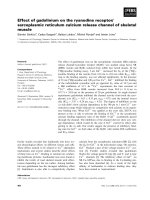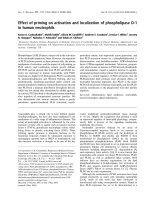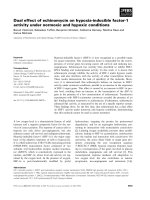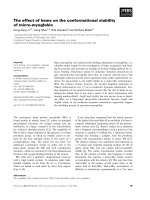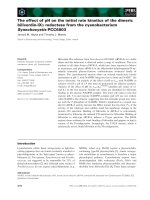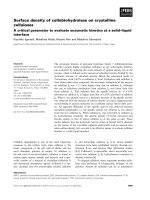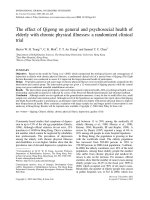Effect of Garlic on Blood Pressure: A MetaAnalysis
Bạn đang xem bản rút gọn của tài liệu. Xem và tải ngay bản đầy đủ của tài liệu tại đây (788.29 KB, 9 trang )
ORIGINAL
PAPER
Effect of Garlic on Blood Pressure: A Meta-Analysis
Hai-Peng Wang, MD;1 Jing Yang, MD;2 Li-Qiang Qin, Professor;3 Xiang-Jun Yang, MD1
From the Department of Cardiovascular, The First Affiliated Hospital of Soochow University, Suzhou, Jiangsu Province, China;1 Department of Clinical
Nutrition, The First Affiliated Hospital of Soochow University, Suzhou, Jiangsu Province, China;2 and Department of Nutrition, Soochow University,
Suzhou, Jiangsu Province, China3
Garlic supplements are thought to reduce blood pressure
(BP). The authors performed a meta-analysis to investigate
garlic’s effect on BP. Ovid Medline, Cochrane Library, and
PubMed (1946 to November 2013) were used to search for
randomized controlled trials. Seventeen trials were included.
Pooled analysis showed that garlic intake caused a 3.75-mm
Hg reduction (95% confidence interval [CI], À5.04 to À2.45,
I2=30.7%; P<.001) in systolic BP and a 3.39-mm Hg
reduction (95% CI, À4.14 to À2.65, I2=67%; P<.001) in
diastolic BP compared with controls. Meta-analysis of
subgroups showed a significant reduction in systolic BP in
hypertensive (À4.4 mm Hg; 95% CI, À7.37 to À1.42,
I2=0.0%; P=.004) but not normotensive patients. No significant reduction in diastolic BP was seen. After sensitivity
analysis, heterogeneity disappeared and significant diastolic
BP reduction (À2.68 mm Hg, 95% CI, À4.93 to À0.42,
I2=0.0%; P=.020) was shown in hypertensive patients. This
meta-analysis suggests that garlic supplements are superior
to controls (placebo in most trails) in reducing BP, especially
in hypertensive patients. J Clin Hypertens (Greenwich).
2015;17:223–231. ª 2015 Wiley Periodicals, Inc.
Worldwide, about 25% of adults have hypertension,
and 7 million deaths per year may be contributed to
hypertension.1 Effective measures must be taken to
control blood pressure (BP) in hypertension patients.
Antihypertensive medicine has been widely used, but its
high cost has caused heavy economic burden to countries and individuals. In addition, side effects and
complications often affect treatment adherence of
hypertension patients. As a result, alternative or complementary therapy for hypertension is being explored.
Garlic is one of the most utilized supplements, with its
antibacterial and antioxidant abilities mainly produced
by allicin in garlic. In recent years, garlic has been
thought to be effective in the treatment of hypertension.
It is reported that allicin has angiotension II–inhibiting
and vasodilating effects.2–4 Phenolic and steroidal compounds in garlic also have pharmacologic effects.5
Evidence from human trials suggests that garlic might
be beneficial in the treatment of hypertension.6–11
However, the results from several previous meta-analysis were contradictory.12–14 In 1994, Silagy and colleagues13 included seven trials and found that garlic
decreased BP in patients with mild hypertension.
Ackermann and colleagues12 performed a meta-analysis
in 2001 to summarize the effects of garlic on several
cardiovascular-related factors and found no significant
effects on BP. Ried and colleagues included 25 studies in
a systematic review and found that garlic preparations
were superior to placebo in reducing BP in individuals
with hypertension.14 During the past few years, a
number of human trials have been carried out, with
new evidence; therefore, we conducted an updated
meta-analysis for the following purposes: (1) to update
the evidence on the association between garlic intake
and BP, and (2) to examine this association according to
dosage and duration.
Address for correspondence: Xiang-Jun Yang, MD, PhD, Department of
Cardiovascular, The First Affiliated Hospital of Soochow University, No. 188
Shizi Road, Suzhou 215006, Jiangsu Province, China
E-mail:
Manuscript received: September 18, 2014; revised: November 20,
2014; accepted: November 21, 2014
DOI: 10.1111/jch.12473
MATERIALS AND METHODS
Search Strategy for Identification of Studies
We searched Ovid Medline, Cochrane Library, PubMed
(January 1946 through November 2013) to identify
randomized controlled trials (RCTs) that examined the
effect of garlic on BP. We used the following terms:
garlic AND blood pressure OR hypertension to identify
intervention studies investigating the effect of garlic on
BP. Reference of important articles were searched
manually for possible relevant studies.
Inclusion/Exclusion Criteria
Studies were included if they met the following criteria:
(1) The study investigated the association between
intake of garlic and BP; (2) the studies included
randomized controlled trials, reporting the following
data: mean systolic and/or diastolic BP (SBP/DBP) and
standard deviation (SD) or standard error; and (3) garlic
was the only active intervention in the treatment group
compared with a control group. Studies were excluded if
they were not randomized or did not have a control
arm, if they lacked enough data for statistical pooling,
or if they did not report BP.
Data Extraction
Data were extracted independently by two researchers
(H-P.W. and J.Y.) according to the described selection
criteria. Disagreement was resolved by discussion with
The Journal of Clinical Hypertension
Vol 17 | No 3 | March 2015
223
Effect of Garlic on Blood Pressure | Wang et al.
the third person (X-J.Y.). The following data were
extracted from the studies: first author’s name, publication year, study design, intervention method, study
period, sample size, outcomes, method used to generate
the randomization, level of blinding, and explanation
for withdrawal or dropout.
Statistical Methods
The net changes were calculated as the difference
between the baseline and final values of BP. If only SD
for the baseline and final values were provided, SD for
the net changes were imputed according to the method
of Follmann using a correlation coefficient of 0.5.
Overall effect size was expressed as weighted mean
difference (WMD) with 95% confidence interval (CI)
using Stata11 (StataCorp, College Station, TX). The
heterogeneity between the studies was tested using the
Q test at the P<.10 level of significance and quantified
by the I² statistic, which describes the inconsistency
across studies. In general, the random-effects model was
used in the presence of significant heterogeneity. In fact,
heterogeneity always exists in varying degrees. Thus,
results from random-effects model, which would be
more conservative (and hence more appropriate), were
presented in our meta-analysis. We performed a sensitivity analysis, in which a single trial was omitted each
time and the effect size was recalculated to investigate
its influence on the overall effect size. Potential publication bias was assessed using Begg’s funnel plots and
Egger’s regression test. P<.05 was considered statistically significant, except where otherwise specified.
RESULT
Search Results
Based on our search strategy, we searched 245 potential
relevant articles, 29 of which were retrieved for further
assessment, and 12 were excluded for the reasons shown
in Figure 1. As a result, 17 studies were included, and
the characteristics of the included studies are listed in
the Table. The detailed selection process is presented in
Figure 1.
Study Characteristics
Among the 17 trials, one included two separate randomcontrolled trials10 that involved hypertensive patients
and normotensive individuals, therefore this trial was
counted as two trials. Therefore, our meta-analysis
included a total of 18 trials, seven of which comprised
hypertensive individuals and six normotensive individuals, another five included both hypertensive and
normotensive individuals. We evaluated measurements
taken to test BP by five criteria: BP device, accuracy
mentioned, body position reported, measurement with
arm at heart level, rest period before measurement, and
number of readings reported. The missing items are
shown in the Table. Fourteen trials used garlic powder
(mainly “kwai”), three trials used aged garlic extract,
and another trial used garlic oil. One trial reported only
224
The Journal of Clinical Hypertension
Vol 17 | No 3 | March 2015
FIGURE 1. Flow diagram of search strategy and study selection.
BP indicates blood pressure.
DBP. Seventeen trials reported both SBP and DBP.
Dosage of garlic powder ranged from 300 mg/d to
2400 mg/d and the duration of intervention ranged
from 2 to 24 weeks. The total number of patients in the
overall analysis for DBP was 799 and for SBP was 735.
Overall Analysis
Results showed a significant difference in favor of the
garlic group, with garlic having a greater effect on
reducing SBP by 3.75 mm Hg (95% CI, À5.04 to
À2.45) compared with control (P<.001) (Figure 2).
There was minor heterogeneity among the studies
(I2=30.7%, P=.111). Meta-analysis of the effect of
garlic on DBP also showed a significant difference
between garlic and control groups, with the garlic group
more effective in reducing DBP than placebo by 3.39
mm Hg (95% CI, À4.14 to À2.65; P<.001) (Figure 3);
however, there was significant heterogeneity among the
studies (I2=67%, P=.000). The methodologic quality of
trials can contribute to the heterogeneity across studies,
so we evaluated methodologic quality of the selected
trials using the nine quality criteria proposed by the
Dutch Cochrane Centre in 2009 (Table). Trials that
scored less than 5 were considered low quality and were
then removed. We reanalyzed high-quality trials and
found that heterogeneity disappeared in both the SBP
and DBP groups. Change in SBP was more obvious,
The Journal of Clinical Hypertension
Single-blind
parallel
Single-blind
parallel
Single-blind
parallel
Parallel
Single-blind
parallel
Saradeth
et al, 199429
Simons
et al, 199530
Steiner
et al, 199631
Adler
et al, 19976
Zhang
et al, 200032
parallel
parallel
et al, 199328
et al, 20108
Single-blind
Kiesewette
parallel
Double-blind
Single-blind
parallel
Jain
et al, 199327
et al, 20097
Ried
Single-blind
parallel
Holzgartner
et al, 199226
crossover
Double-blind
Single-blind
parallel
Vorberg
et al, 199025
et al, 200533
Sobenin
Single-blind
parallel
Auer
et al, 199024
Double-blind
parallel
Kandziora et
al, 198823
William
Trial Design
Author, y
42
50
30
27
23
56
30
52
64
42
94
40
47
40
Patients, No.
H
H
H+N
N
N
H+N
N
N
H+N
N
H+N
H+N
H
H
BP
Vol 17 | No 3 | March 2015
vs placebo
vs placebo
AGE 960 mg
vs placebo
GP 600 mg/d
GP 600 mg/d
vs placebo
vs placebo
GO 12.3 mg/d
vs placebo
GP 900 mg/d
AGE 2400 mg
GP 900 mg/d
vs placebo
GP 900 mg/d
vs placebo
vs placebo
GP 800 mg/d
GP 900 mg/d
vs placebo
drug vs
lipid-lowering drug
GP 900
mg/d+lipid-lowering
GP 900 mg/d
vs placebo
GP 600 mg/d
vs placebo
GP 600 mg/d+diuretic
drug vs drug only
Method
Interventional
12 wk
8 wk
2 wk
12 wk
12 wk
12 wk
12 wk
15 wk
12 wk
EB
AC EB ITT
AC EB ITT
AC, EB, D, ITT
AC, PB, EB, CG, ITT
AC, EB, CG, D, ITT
AC, EB, CG, ITT
AC, EB, CG, D, ITT
AC, EB, D, ITT
AC, EB, D, ITT
AC, EB, IT, ST
12 wk
12 wk
AC, EB, CG, ITT
AC, EB, CG, D, ITT
AC, PB, EB, D, ITT
8
6
6
6
4
4
5
4
5
5
5
5
4
4
(maximum 9)a
Checklista
16 wk
12 wk
12 wk
Duration
Total Points
Quality Scale
Lacking Items
Through Cochrane
TABLE. Charateristics of Trials Included in the Meta-Analysis on the Effect of Garlic on BP
All reported
RP, NR
DM AH RP
DM, AH, BP,
BP, AH
DM, AH, RP, NR
BP, AH, RP, NR
AH
DM, AH, BP,
RP, NR
DM, AH, NR
AH
DM, AH, BP,
RP, NR
DM, AH, RP, NR
DM, AH, RP, NR
DM, AH, RP
(Lacking Items)
BP Measurement
nurse with automated sphygmomanometer
sitting, standing every 4 wk
Office measurements by trained research
Morning BP, right and left arm, supine,
BP values were utilized
BP measurement was not described
The means of the three lowest pulse
rates plus associated systolic and diastolic
min in a quiet standardized environment,
repeated low values were obtained.
using a medical digital BP meter, 10–30
digital BP monitor
BPs were determined on the upper arm
measurement with sphygmomanometer
Sitting BPs were taken at each visit by a
readings
BPs were monitored by manual
BPs were measured after 5 min seated rest,
used phase V diastolic, mean of two
Resting BP was recorded using the
traditional Riva Rocci method
to the method of Riva Rocci, lying position
after 10 min of rest
and standard recommended technique
BP was determined once a week according
clinic using an appropriate-sized cuff, a
conventional mercury sphygmomanometer,
Two sitting BP measurements were
obtained after 10 minutes of rest in the
BP measurement was not described
and at 2, 4, 8, 12, and 16 wk after
baseline
BP measurements at office. Supine and
upright, before beginning, after washout,
BP measurements at office. Supine and
standing at À2, 0, 4, 8, and 12 wk
Supine and standing after 0, 2, 4, 8,
and 12 wk; 2 measurements every visit
BP Measurement
Effect of Garlic on Blood Pressure | Wang et al.
225
226
The Journal of Clinical Hypertension
Vol 17 | No 3 | March 2015
Double-blind
parallel
Double-blind
parallel
Single-blind
parallel
Nakasone
et al, 201310b
Nakasone
et al, 201310b
Ashraf
et al, 201311
57
32
40
33
Patients, No.
H
N
H
H
BP
vs placebo
GP 900 mg/d
GP 300 mg/d
vs placebo
GP 300 mg/d
vs placebo
AGE 960 mg
vs placebo
Method
24 wk
12 wk
12 wk
12 wk
Duration
AC EB RB ITT D
AC
AC
4
8
8
8
(maximum 9)a
Checklista
EB
Total Points
Quality Scale
Lacking Items
Through Cochrane
RP, NR
DM, AH, BP,
AH
AH
All reported
(Lacking Items)
BP Measurement
Measurements at 0, 4, 8, and 12 wk
BP measurement was not described
measurements ≤5 mm Hg. Mean values
of 2 such measurements were then used.
arm, repeated measurements at 2-min
intervals, until variance of 2 successive
Office measurements, automated
sphygmomanometer. Sitting position. Left
were then used. Measurements at 0, 4, 8,
and 12 wk
successive measurements ≤5 mm Hg.
Mean values of 2 such measurements
Left arm, repeated measurements
at 2-min intervals, until variance of 2
Office measurements, automated
sphygmomanometer. Sitting position.
mean of 3 readings at intervals of 30 s.
Measurements at 0, 4, 8, and 12 wk
sphygmomanometer. Sitting position.
The arm with higher reading was used,
Office measurements by trained research
nurse with automated
readings at intervals of 30 s.
Measurements at 0, 4, 8, and 12 wk
while in the sitting position. The arm with
higher reading was used. Mean of 3
BP Measurement
blinding; RP, resting period; ST, same treatment of groups. aDutch Cochrane Centre: checklist for bias assessing of randomized controlled trials. bThis study included two separated randomizedcontrolled trials involving hypertensive and normotensive patients.
Abbreviations: AC, allocation concealment; AGE, aged garlic extract; AH, arm at heart level; BP, body position or blood pressure; CG, comparable groups; D, dropouts; DM, device mentioned; EB,
evaluators blinded; GO, garlic oil; GP, garlic powder; H, hypertensive; H+N, hypertensive and normotensive; ITT, intention-to-treat analysis; N, normotensive; NR, number of reading; PB, patient
Double-blind
parallel
Trial Design
Ried
et al, 20129
Author, y
Interventional
TABLE. Charateristics of Trials Included in the Meta-Analysis on the Effect of Garlic on BP (Continued)
Effect of Garlic on Blood Pressure | Wang et al.
Effect of Garlic on Blood Pressure | Wang et al.
FIGURE 2. Effect of garlic on systolic blood pressure. WMD indicates weighted mean difference; CI, confidence interval; I-squared,
inconsistency.
with a reduction of 3.85 mm Hg (95% CI, À5.71 to
À2.01, I2=0.0%; P<.001) (Figure S1); the reduction in
DBP was 1.59 mm Hg (95% CI, À2.91 to À0.26,
I2=8.4%; P=.019) (Figure S2).
Subgroup and Sensitivity Analysis
To further explore the effect of garlic on BP, we
conducted a subgroup analysis in the hypertensive and
normotensive groups. To avoid confusion of results, trials
in which BP were not recorded separately for hypertensive
and normotensive people were excluded. Meta-analysis
by subgroup showed that in patients with hypertension,
the mean reduction in SBP was 4.4 mm Hg (95% CI,
À7.37 to À1.42, I2=0.0%; P=.004) and there was no
significant reduction for DBP, but there existed heterogeneity (I2=32.3%) (Figures 4 and 5). We conducted a
sensitivity analysis and found that one trial8 may generate
heterogeneity; therefore, we removed this trial and the
heterogeneity disappeared and the DBP reduction was
2.68 mm Hg (95% CI, À4.93 to À0.42, I2=0.0%;
P=.020) (Figure S3) in the garlic group. Subgroup analysis
of studies in the normotensive group showed no
significant difference on SBP and DBP between the garlic
and placebo groups with no heterogeneity among studies.
Dose-Response Relationship and Duration
There were two trials that investigated multiple levels of
garlic intake. Garlic supplementation was presented at
240 mg, 480 mg, and 960 mg daily for 12 weeks in the
first trial.9 The maximum antihypertensive effect of
garlic was produced by 480 mg garlic at week 12. There
was no obvious trend with increased dose at week 4
(Figure S4). In another trial,11 patients received garlic
supplementation at the doses of 300 mg, 600 mg,
900 mg, 1200 mg, and 1500 mg per day for 24 weeks.
BP was measured at week 0, week 12, and week 24. The
SBP in the garlic group decreased more significantly
with increased dose and duration (Figure S5). However,
there were only two papers that aimed to study the doseresponse relationship and duration, and the garlic
supplement used in the two trials were different. As a
result, it was inappropriate to pool the data together,
and only the dose and duration effect on SBP in the two
trials were used.
The Journal of Clinical Hypertension
Vol 17 | No 3 | March 2015
227
Effect of Garlic on Blood Pressure | Wang et al.
FIGURE 3. Effect of garlic on diastolic blood pressure. WMD indicates weighted mean difference; CI, confidence interval; I-squared,
inconsistency.
Publication Bias
There was little evidence of publication bias with regard
to garlic supplementation in relation to BP (including
SBP and DBP), as indicated by the Begg rank correlation
test (P>.05) and the Egger linear regression test (P>.05).
DISCUSSION
Garlic has been used worldwide as traditional food, and
has been considered to have therapeutic effects on some
human diseases.15 At first, garlic was thought to be useful
in decreasing serum cholesterol concentration.16
Recently, several studies have shown that garlic supplements can decrease BP.6–11 However, the meta-analysis
by Ackermann and colleagues found that garlic had no
significant effects on BP.12 Nine years later, another metaanalysis showed that garlic preparations were superior to
placebo in reducing BP in individuals with hypertension.14 Including some new trials, we performed an
updated meta-analysis and found that garlic supplements
caused significant reduction in BP and that both SBP and
DBP can be lowered at different degrees. However,
heterogeneity existed among studies, especially in the
DBP group. We re-analyzed the data after exclusion of the
low-quality trials and no heterogeneity existed and the
result still showed that both SBP and DBP were significantly decreased. To avoid confusion of results, studies
that mixed hypertension and normotension participants
228
The Journal of Clinical Hypertension
Vol 17 | No 3 | March 2015
together were excluded. Meta-analysis of subgroups
showed that garlic supplementation led to a significant
fall in SBP in the hypertensive group but no significant
decrease in the normotensive group. However, with
regard to DBP, no significant change was shown in either
the hypertensive or normotensive groups. Because of the
heterogeneity in the DBP group, we conducted a sensitivity analysis and found that one trial8 may generate
heterogeneity, and when this trial was removed, we recalculated the meta-analysis and found that the heterogeneity disappeared and a significant DBP reduction was
shown in the hypertensive group. Our findings were
consistent with a previous meta-analysis by Ried and
colleagues in 2008.14 We believe our meta-analysis has
some advantages as it included new trials7–11 and
evaluated the methodological quality of the selected trials
using the nine quality criteria proposed by the Dutch
Cochrane Centre in 2009 (Table). We reanalyzed the
high-quality trials after the low-quality trials were
removed and found that a significant reduction in both
SBP and DBP still existed in the garlic-treat group. Our
study provides further support for garlic supplementation
in hypertensive patients.
The mechanism of garlic’s antihypertensive effect is
still not clear. There are some hypotheses, however.
Increased oxidative stress can induce endothelial dysfunction, and can eventually lead to hypertension.17,18
Effect of Garlic on Blood Pressure | Wang et al.
FIGURE 4. Subgroup analysis on the effect of garlic on systolic blood pressure. 1 indicates normotensive; 2, hypertensive; WMD, weighted
mean difference; CI, confidence interval; I-squared, inconsistency.
FIGURE 5. Subgroup analysis on the effect of garlic on diastolic blood pressure. 1 indicates normotensive; 2, hypertensive; WMD, weighted
mean difference; CI, confidence interval; I-squared, inconsistency.
The Journal of Clinical Hypertension
Vol 17 | No 3 | March 2015
229
Effect of Garlic on Blood Pressure | Wang et al.
Garlic contains several bioactive compounds, including
allicin, which has antioxidant activity.19 Some studies
showed that allicin could lower BP.20 Therefore, garlic
supplements may ameliorate hypertension by its antioxidant effect. Garlic may elicit its antihypertensive
effects by inhibition of angiotensin-converting enzymes
(ACEs). Sharifi and colleagues found that garlic and
allicin could decrease ACE activity in a hypertensive rat
model, and they also found that compared with the
control group, a significant reduction in SBP was noted
in rats treated with garlic.2 However, several dipeptides
extracted from garlic have also been reported to inhibit
ACE,21 and allicin may not be the only compound that
has ACE inhibitory activity. Nonetheless, garlic can
decrease BP by inhibiting ACE.
We also investigated the dose-response relationship
and duration in the trials. The dosage of garlic supplement in the hypertension groups was 600 mg or 900 mg
in most of the studies. We cannot find a dose-response
relationship in the meta-regression. Moreover, it is
known that the dose-response relationship from metaregression should be viewed as exploratory and could be
prone to confounding.22 We tried to observe the doseeffect relationship from trials with multiple levels of
garlic intake. There were two trials that studied at least
three levels of garlic intake. The first study by Ried and
colleagues in 20129 was a double-blind, randomized,
placebo-controlled trial comprising 79 participants with
systolic hypertension in which 240 mg, 480 mg, and
960 mg daily garlic supplements were administered for
12 weeks. Change in SBP in the 240-mg group was not
significantly different from placebo. No obvious reduction was found in SBP in the 960-mg group compared
with the 480-mg group. The maximum effect was
produced by garlic in 480 mg. Possible reasons were as
follows: (1) poorer compliance and less tolerability was
reported in the 960-mg group; (2) whether garlic in 480
mg has exerted its maximum effect was unknown, but
other evidence suggests that this was unlikely. In
Ashraf’s study,11 hypertensive patients received garlic
supplementation at the doses of 300 mg, 600 mg,
900 mg, 1200 mg, and 1500 mg per day for 24 weeks.
Data were compared at week 12 and week 24. BP
decreased with the increased intake of garlic, and the
maximum effect was produced by 1500 mg of garlic at
week 24. Unfortunately, the quality of the study was
poor. Because the studies reported multiple dosages and
the duration was limited, it was difficult for us to detect
an association between the dosage and duration with BP
change. More trials should be conducted to explore this
relationship in the future.
Study Strengths and Limitations
Our meta-analysis included several studies in which the
patients were given hypotensive medicine, which may
influence the hypotensive effect of garlic, but only patients
who were already taking conventional antihypertensive
medication and not planning to change the prescribed
230
The Journal of Clinical Hypertension
Vol 17 | No 3 | March 2015
medication during the trial were included. In addition,
heterogeneity was not reported after elimination of a
low-quality study.
The garlic supplements were not the same among the
17 trials. The supplements included garlic powder, aged
garlic extract, and garlic oil, which may have different
effects on BP. However, the active ingredients in the
different garlic supplements is allicin, and, in our metaanalysis, most trials used garlic powder in dosages
ranging from 300 mg/d to 900 mg/d, providing 1.8 mg
to 5.4 mg of allicin. In one trial, Zhang and colleagues
used garlic oil, which is an allicin derivative produced
by the steam-distillation process. Three trials used aged
garlic extract (Kyolic and Wakunaga of America Kyolic), which may contain 1% to 2% of allicin.
There might be issues related to the measurement of
BP in these trials and this is crucial to the research
question. In some papers, the method of BP taking were
described in detail. In the trial by Ried and colleagues,
for example, BP was tested by trained nurse, and the
reported BP was the average of three times repeated
measurements using standard techniques. However, in
some trials, BPs were measured only once, and some
papers did not describe the manner of BP testing
(Table 1). This may have influenced the results of the
studies.
Finally, one study was included twice,10 which may
have increased its weight in the meta-analysis; however,
two independent trials were performed in this study and
were considered as such.
CONCLUSIONS
Our meta-analysis suggests that garlic supplementation
is superior to placebo in reducing BP in hypertensive
patients, especially in those with high SBP. More trials
should be performed to explore the association between
dosage and duration of garlic and change in BP. The
safety of long-term use should also be investigated before
garlic is used as conventional therapy for hypertension.
Disclosures: The authors report no specific funding in relation to this research
and no conflicts of interest to disclose.
Reference
1. Fagard RH. Resistant hypertension. Heart. 2012;98:254–261.
2. Benavides GA, Squadrito GL, Mills RW, et al. Hydrogen sulfide
mediates the vasoactivity of garlic. Proc Natl Acad Sci USA.
2007;104:17977–17982.
3. Sharifi AM, Darabi R, Akbarloo N. Investigation of antihypertensive
mechanism of garlic in 2K1C hypertensive rat. J Ethnopharmacol.
2003;3:219–224.
4. Al-Qattan KK, Khan I, Alnaqeeb MA, Ali M. Mechanism of garlic
(Allium sativum) induced reduction of hypertension in 2K-1C rats: a
possible mediation of Na/H exchanger isoform-1. Prostaglandins
Leukot Essent Fatty Acids. 2003;69:217–222.
5. Lanzotti V. The analysis of onion and garlic. J Chromatogr A.
2006;2:3–22.
6. Adler AJ, Holub BJ. Effect of garlic and fish-oil supplementation on
serum lipid and lipoprotein concentrations in hypercholesterolemic
men. Am J Clin Nutr. 1997;65:445–450.
7. Sobenin IA, Andrianova IV, Fomchenkov IV, et al. Time-released
garlic powder tablets lower systolic and diastolic blood pressure in
men with mild and moderate arterial hypertension. Hypertens Res.
2009;32:433–437.
Effect of Garlic on Blood Pressure | Wang et al.
8. Ried K, Frank OR, Stocks NP. Aged garlic extract lowers blood
pressure in patients with treated but uncontrolled hypertension: a
randomised controlled trial. Maturitas. 2010;67:144–150.
9. Ried K, Frank OR, Stocks NP. Aged garlic extract reduces blood
pressure in hypertensives: a dose-response trial. Eur J Clin Nutr.
2013;67:64–70.
10. Nakasone Y, Nakamura Y, Yamamoto T, Yamaguchi H. Effect of a
traditional Japanese garlic preparation on blood pressure in prehypertensive and mildly hypertensive adults. Exp Ther Med.
2013;5:399–405.
11. Ashraf R, Khan RA, Ashraf I, Qureshi AA. Effects of Allium sativum
(garlic) on systolic and diastolic blood pressure in patients with
essential hypertension. Pak J Pharm Sci. 2013;26:859–863.
12. Ackermann RT, Mulrow CD, Ramirez G, et al. Garlic shows promise
for improving some cardiovascular risk factors. Arch Intern Med.
2001;161:813–824.
13. Silagy CA, Neil HA. A meta-analysis of the effect of garlic on blood
pressure. J Hypertens. 1994;12:463–468.
14. Ried K, Frank OR, Stocks NP, et al. Effect of garlic on blood pressure:
a systematic review and meta-analysis. BMC Cardiovasc Disord.
2008;8:13.
15. Rivlin RS. Historical perspective on the use of garlic. J Nutr.
2001;131:951S–954S.
16. Gebhardt R, Beck H, Wagner K. Inhibition of cholesterol biosynthesis
by allicin and ajoene in rat hepatocytes and HepG2 cells. Biochim
Biophys Acta. 1994;1213:57–62.
17. Cai H, Harrison DG. Endothelial dysfunction in cardiovascular
diseases: the role of oxidant stress. Circ Res. 2000;87:840–844.
18. Laursen JB, Rajagopalan S, Galis Z, et al. Role of superoxide in
angiotensin II-induced but not catecholamine-induced hypertension.
Circulation. 1997;95:588–593.
19. Prasad K, Laxdal VA, Yu M, Raney BL. Antioxidant activity of
allicin, an active principle in garlic. Mol Cell Biochem. 1995;148:183–
189.
20. Ali M, Al-Qattan KK, Al-Enezi F, et al. Effect of allicin from garlic
powder on serum lipids and blood pressure in rats fed with a high
cholesterol diet. Prostaglandins Leukot Essent Fatty Acids.
2000;62:253–259.
21. Seutsuna K. Isolation and characterization of angiotensin I-converting
enzyme inhibitor dipeptides derived from Allium sativum L (garlic).
J Nutr Biochem. 1998;9:415–419.
22. He FJ, Li J, Macgregor GA. Effect of longer term modest salt
reduction on blood pressure: cochrane systematic review and metaanalysis of randomised trials. BMJ. 2013;346:f1325.
23. Kandziora J . The blood pressure lowering and lipid lowering effect of
a garlic preparation in combination with a diuretic. Artzliche
Forschung. 1988;35:3–8.
24. Auer W, Eiber A, Hertkorn E, et al. Hypertension and hyperlipidaemia: garlic helps in mild cases. Br J Clin Pract Suppl. 1990;69:3–6.
25. Vorberg G, Schneider B. Therapy with garlic: results of a placebocontrolled, double-blind study. Br J Clin Pract Suppl. 1990;69:7–11.
26. Holzgartner H, Schmidt U, Kuhn U. Comparison of the efficacy and
tolerance of a garlic preparation vs. bezafibrate. Arzneimittelforschung. 1992;42:1473–1477.
27. Jain AK, Vargas R, Gotzkowsky S, McMahon FG. Can garlic reduce
levels of serum lipids? A controlled clinical study Am J Med.
1993;94:632–635.
28. Kiesewetter H, Jung F, Jung EM, et al. Effects of garlic coated tablets
in peripheral arterial occlusive disease. Clin Investig. 1993;71:383–
386.
29. Saradeth T, Seidl S, Resch KL, Ernst E. Does garlic alter the lipid
pattern in normal volunteers? Phytomedicine. 1994;1:183–185.
30. Simons LA, Balasubramaniam S, von Konigsmark M, et al. On the
effect of garlic on plasma lipids and lipoproteins in mild hypercholesterolaemia. Atherosclerosis. 1995;113:219–225.
31. Steiner M, Khan AH, Holbert D, Lin RI. A double-blind crossover
study in moderately hypercholesterolemic men that compared the
effect of aged garlic extract and placebo administration on blood
lipids. Am J Clin Nutr. 1996;64:866–870.
32. Zhang XH, Lowe D, Giles P, et al. A randomized trial of the effects of
garlic oil upon coronary heart disease risk factors in trained male
runners. Blood Coagul Fibrinolysis. 2001;12:67–74.
33. Williams MJ, Sutherland WH, McCormick MP, et al. Aged garlic
extract improves endothelial function in men with coronary artery
disease. Phytother Res. 2005;19:314–319.
Supporting Information
Additional Supporting Information may be found in the
online version of this article:
Figure S1. Effect of garlic on systolic blood pressure
after excluding low quality trials.
Figure S2. Effect of garlic diastolic blood pressure
after excluding low quality trials.
Figure S3. Effect of garlic on diastolic blood pressure
in normotensive/hypertensive after excluding trial hold
by Ried in 2010.
Figure S4. Dose-response relationship and duration in
the trial hold by Reid et al in 2012.
Figure S5. Dose-response relationship and duration in
the trial hold by Ashraf et al in 2013.
The Journal of Clinical Hypertension
Vol 17 | No 3 | March 2015
231


